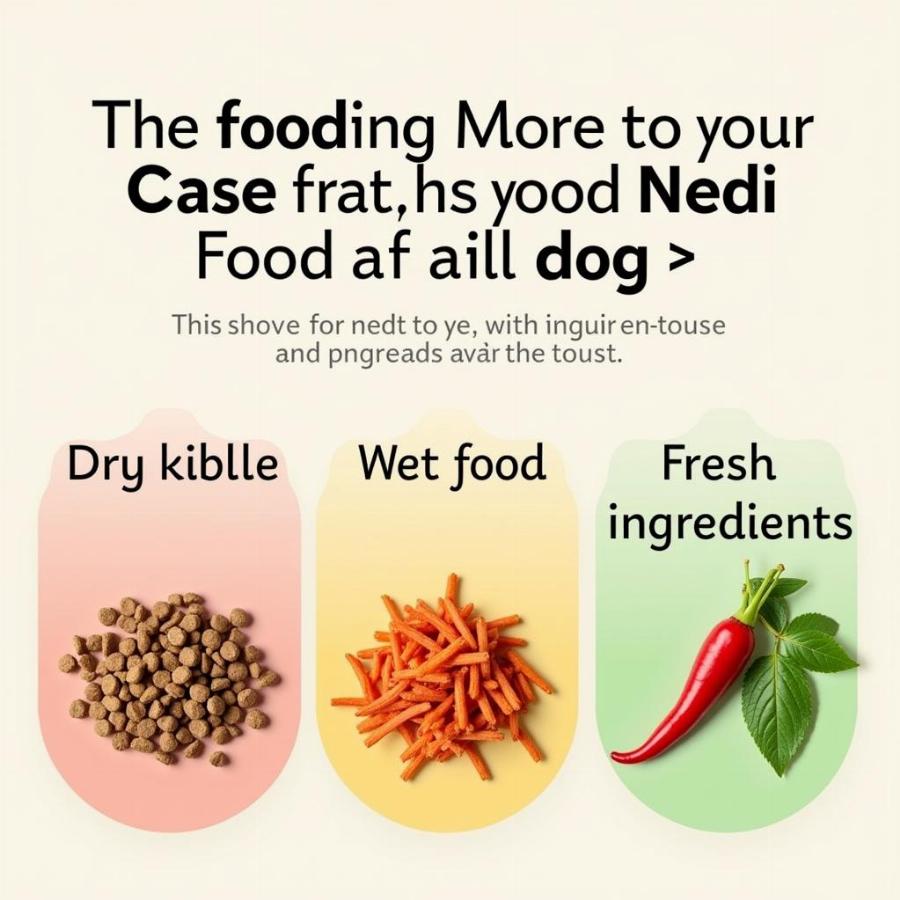Feeding your dog is more than just filling a bowl. It’s about providing the proper nourishment for a healthy, happy life. This guide covers everything you need to know about how to fed the dog, from choosing the right food to establishing healthy eating habits.
Understanding Your Dog’s Nutritional Needs
Just like humans, dogs require a balanced diet of proteins, fats, carbohydrates, vitamins, and minerals. However, the specific amounts vary based on factors like age, breed, activity level, and overall health. Puppies, for instance, need more calories and nutrients for growth than adult dogs. Similarly, highly active breeds like Border Collies require more energy than less active breeds like Bulldogs. Understanding these individual needs is crucial when choosing the right food to fed the dog.
 Chó cảnh ăn thức ăn
Chó cảnh ăn thức ăn
Choosing the Right Dog Food: Kibble, Wet, or Raw?
The market offers a vast selection of dog foods, making the choice overwhelming. You’ll encounter kibble, wet food, raw diets, and even homemade meals. Kibble is convenient and generally more affordable. Wet food is often more palatable, especially for picky eaters. Raw diets have gained popularity, but require careful preparation and handling to avoid bacterial contamination. When you fed the dog, make sure to read labels carefully, looking for high-quality ingredients and avoiding fillers like corn and wheat. Always consult your veterinarian for personalized recommendations tailored to your dog’s specific requirements.
How Much and How Often Should You Fed the Dog?
Feeding frequency depends on age and sometimes breed. Puppies typically require multiple small meals throughout the day, while adult dogs can generally thrive on one or two meals. Overfeeding can lead to obesity, while underfeeding can result in malnutrition. Follow the feeding guidelines on the dog food packaging, but adjust portions based on your dog’s weight, activity level, and body condition. Regularly monitor your dog’s weight and consult your veterinarian to ensure you’re feeding the correct amount.
Establishing Healthy Eating Habits
Just like humans, dogs can benefit from consistent mealtimes. Establish a regular feeding schedule and stick to it as closely as possible. Avoid free-feeding, which can lead to overeating and make it difficult to monitor food intake. Create a calm and comfortable eating environment free from distractions. And remember, treats should be given sparingly and factored into the dog’s daily caloric intake. Never fed the dog table scraps, as many human foods are toxic to dogs.
What if My Dog is a Picky Eater?
Dealing with a picky eater can be frustrating. Sometimes, a simple change in flavor or texture can entice a reluctant eater. Try warming up wet food or mixing it with a small amount of kibble. You can also try adding a spoonful of plain, unsweetened yogurt or cooked chicken to make the food more appealing. However, avoid making mealtimes a power struggle. If your dog consistently refuses to eat, consult your veterinarian to rule out any underlying medical issues.
Conclusion
Feeding your dog correctly is fundamental to their overall health and well-being. By understanding their nutritional needs, choosing the right food, and establishing healthy eating habits, you can ensure your furry companion thrives. Remember to consult your veterinarian for personalized advice, as they can offer tailored recommendations based on your dog’s individual circumstances.
FAQ
- How do I transition my dog to a new food? Gradually introduce the new food over several days, mixing increasing amounts with the old food.
- Can I give my dog supplements? Consult your veterinarian before giving any supplements.
- What are some signs of food allergies in dogs? Itching, skin irritation, digestive upset, and ear infections can be signs of food allergies.
- Is it okay to feed my dog human food? Many human foods are toxic to dogs. Stick to dog-specific food and treats.
- How can I tell if my dog is overweight? You should be able to feel their ribs easily but not see them prominently.
More Resources on Beaut Dogs
You might also find these articles helpful:
Beaut Dogs: Your Trusted Source for Canine Information
Beaut Dogs is your one-stop resource for all things dog-related, offering expert advice and guidance on every aspect of dog ownership. From breed information to health tips, we’re dedicated to helping you provide the best possible care for your furry friend. For personalized support and answers to your specific questions, contact us at Email: [email protected]. We’re here to help you navigate the wonderful world of dog ownership.